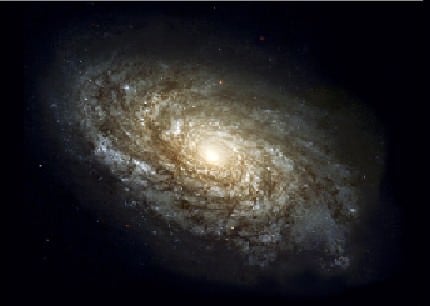[/caption] If you're certain the Universe revolves around you, I have some bad news for you. Researchers from the University of British Columbia say Earth's location in the Universe is utterly unremarkable, despite recent theories that propose Earth is at the center of a giant void in space. A decade ago, it was discovered the Universe's expansion was accelerating. This continually expanding Universe was attributed to dark energy, the highly repulsive and mysterious stuff that has yet to be detected. But some scientists came up with an alternate theory where Earth was near the centre of a giant void or bubble, mostly empty of matter. But new calculations solidify the case that dark energy permeates the cosmos.
While dark energy sometimes seems pretty far-fetched – with its mysterious and so far undetectable properties – the alternate "void" theory of why the Universe is ever-expanding contains a problem, in that it violates the long held Copernican Principle.
Polish astronomer Nicolaus Copernicus's 1543 book, On the Revolutions of the Heavenly Spheres, moved Earth from being the
center of the Universe
to just another planet orbiting the Sun. Since then, astronomers have extended the idea and formed the Copernican Principle, which says that our place in the Universe as a whole is completely ordinary. Although the Copernican Principle has become a pillar of modern cosmology, finding conclusive evidence that our neighborhood of the Universe really isn't special has proven difficult. [caption id="attachment_22915" align="aligncenter" width="205" caption="Nicolaus Copernicus "]
[/caption] In 1998, studies of distant explosions called "type Ia supernovae" indicated that the expansion of the Universe is accelerating, an observation attributed to the repulsive force of a mysterious "dark energy." But some cosmologist proposed that Earth was at the center of a void, and that gravity would create the illusion of acceleration, mimicking the effect of dark energy on the supernova observations.
Now some advanced analysis and modeling performed by UBC post-doctoral fellows Jim Zibin and Adam Moss and Astronomy Prof. Douglas Scott is showing that this alternate "void theory" just doesn't add up.
The researchers used data from the Wilkinson Microwave Anisotropy Probe satellite, which includes members from UBC on its international team, as well as data from various ground-based instruments and surveys.
"We tested void models against the latest data, including subtle features in the cosmic microwave background radiation – the afterglow of the Big Bang – and ripples in the large-scale distribution of matter," says Zibin. "We found that void models do a very poor job of explaining the combination of these data."
The team's calculations instead solidify the conventional view that an enigmatic dark energy fills the cosmos and is responsible for the acceleration of the Universe. "Recent advances in data collection have brought us to the era of precision cosmology," says Zibin. "Void models are terrible at explaining the new data, but the standard dark energy model works very well.
"Since we can only observe the Universe from Earth, it's really hard to determine if we're in a 'special place,'" says Zibin. "But we've now learned that our location is much more ordinary than the strange dark energy that fills the Universe."
The team's research is available at
Physical Review Letters
Source:
EurekAlert
 Universe Today
Universe Today
